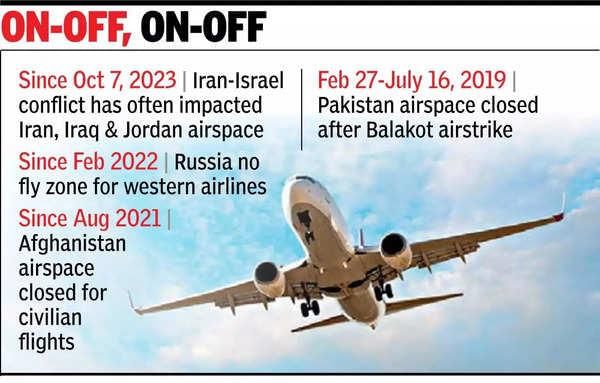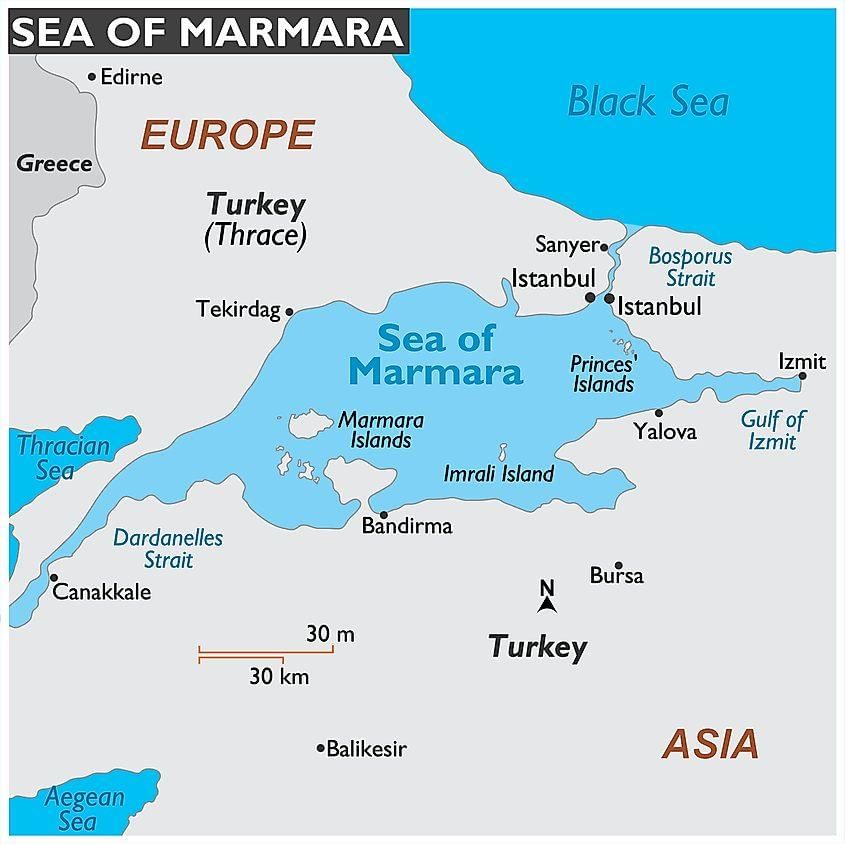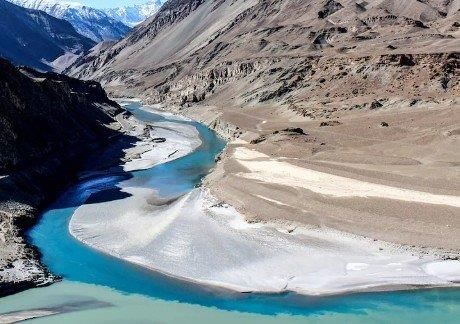UPSC Daily Current Affairs: 26th April 2025 | Current Affairs & Hindu Analysis: Daily, Weekly & Monthly PDF Download
GS2/International Relations
Pakistan Airspace Closure to Hit Indian Carriers
 Why in News?
Why in News?
The recent decision by Pakistan to close its airspace to Indian airlines is projected to significantly affect over 800 weekly flights. This closure will result in longer travel times, increased fuel consumption, and challenges in crew and flight scheduling for Indian carriers.
- The airspace closure impacts all west-bound flights from northern cities in India, particularly Delhi, to various international destinations.
- Indian airlines may face increased operational costs and potential fare hikes due to longer flight routes.
- Air India is expected to bear the brunt of this closure, affecting its international operations.
Additional Details
- Scope of the Ban: Pakistan has prohibited all aircraft registered in India or operated by Indian carriers from accessing its airspace.
- Affected Routes: The closure predominantly impacts flights heading to Central Asia, the Caucasus, West Asia, Europe, the UK, and North America.
- Longer Flight Paths: Airlines will have to reroute flights over the Arabian Sea, which will extend travel times and increase fuel consumption.
- Operational Challenges: Airlines may need to adjust fuel management and payload, possibly reducing passenger numbers or baggage to comply with weight limits.
- Increased Costs and Airfares: Operational costs are likely to rise due to longer routes, with airfares on international routes potentially increasing by 8–12%.
- Competitive Disadvantage: Foreign airlines that can utilize Pakistani airspace will have a cost advantage over Indian carriers on shared routes.
- Most Affected Airline: Air India, which operates numerous direct flights from Delhi to Europe, the US, and Canada, is anticipated to be the most affected.
- Uncertainty in Flight Plans: Airlines are currently assessing routing options, with more definitive plans expected to emerge soon.
- IndiGo’s Growing Exposure: Since 2019, IndiGo has expanded its operations into Central Asia, Turkey, and the Caucasus, making it the only Indian carrier in those regions, which will face significant impacts from these restrictions.
In summary, this airspace closure by Pakistan has far-reaching implications for Indian airlines, particularly in terms of operational efficiency and financial performance, echoing the significant disruptions experienced during Pakistan's previous airspace closure in February 2019.
GS3/Environment
India to Ban Chlorpyrifos
 Why in News?
Why in News?
Policymakers and scientists are convening in Geneva for the Conferences of the Parties to the Basel, Rotterdam, and Stockholm (BRS) Conventions. India's Pesticide Action Network is advocating for a global ban on Chlorpyrifos, a toxic pesticide that remains in use despite being banned in over 40 countries.
- Chlorpyrifos: An organophosphate pesticide used for controlling pests on various crops.
- Health Risks: Linked to serious health issues, including developmental disorders and cancer.
- Environmental Concerns: Highly toxic to aquatic life and pollinators, causing biodiversity loss.
Additional Details
- About Chlorpyrifos: This pesticide is used on crops such as corn, soybeans, and fruits, as well as in non-crop areas like turf and buildings. It acts by disrupting the nervous system of pests through the inhibition of acetylcholinesterase, an essential enzyme.
- Current Status in India: Although not entirely banned, Chlorpyrifos is registered under the Insecticides Act of 1968 with restrictions on its use on certain crops like ber, citrus, and tobacco as per a 2023 notification. However, it is still used on crops including rice, cotton, groundnut, and onion.
- Global Context: India is one of the largest producers and exporters of Chlorpyrifos, which raises concern over the health and environmental implications.
- Threats Posed by Chlorpyrifos:
- Human Health Risks: Associated with developmental disorders in children, cancer, and damage to liver and kidneys.
- Environmental Impact: Toxic to aquatic life and pollinators like bees.
- Soil & Crop Contamination: Persistent in the environment, leading to pesticide residue in the food chain.
- Biodiversity Loss: Disrupts ecosystems by affecting non-target species.
- Resistance Issues: Overuse leads to pesticide resistance, necessitating the use of more harmful chemicals for pest control.
In summary, the ongoing discussions and proposed actions regarding Chlorpyrifos highlight the urgent need to address the health and environmental risks associated with its use, particularly in India where it remains prevalent despite global bans.
GS1/Geography
Places in News: Sea of Marmara
 Why in News?
Why in News?
A significant earthquake measuring 6.2 in magnitude recently struck Istanbul and its surrounding areas, with its epicenter located beneath the Sea of Marmara.
- The Sea of Marmara serves as a crucial transition zone between the Black Sea and the Aegean Sea.
- It has both geographical and cultural significance, delineating the boundary between Asia and Europe in Turkey.
Additional Details
- Geographical Size: The Sea of Marmara spans approximately 11,350 km², measuring about 280 km long and 80 km wide.
- Connections: It is linked to the Black Sea in the northeast by the Bosphorus Strait and to the Aegean Sea in the southwest via the Dardanelles Strait.
- The sea experiences a unique fresh-to-salty water transition due to the influx of cold, fresh water and warmer, saltier water.
- Climate: The region has a humid subtropical climate characterized by hot summers and cold, wet winters, which greatly influences its marine ecosystem.
- The North Anatolian Fault runs beneath the Sea of Marmara, posing significant earthquake risks, including the recent quake.
- Notable islands in the Sea include Marmara Island (the largest) and the Prince Islands.
- The city of Istanbul lies along the coastline of the Sea of Marmara.
This earthquake highlights the geological activity in the region and the importance of understanding the natural hazards associated with the Sea of Marmara.
GS3/Economy
India Considers Allowing 49% Foreign Investment in Nuclear Power Plants
 Why in the News?
Why in the News?
The Indian government is considering a significant policy shift that would allow foreign companies to own up to 49% of nuclear power facilities, a move aimed at enhancing the nation’s clean energy capacity and reducing dependence on coal.
- Proposed policy to allow 49% foreign ownership in India’s nuclear power sector.
- Amendments to the Atomic Energy Act and Civil Liability for Nuclear Damage Act are planned.
- Potential investments from Indian private conglomerates totaling around $26 billion.
- Target to increase nuclear energy capacity from 8 GW to 100 GW by 2047.
Additional Details
- Nuclear Energy's Role: Currently, nuclear energy contributes just over 8 GW, accounting for about 2% of India’s total installed electricity capacity.
- Legal Framework: The Atomic Energy Act of 1960 restricts nuclear energy operations to state-owned entities, with no provisions for private or foreign ownership.
- Investment Interest: Major foreign firms, including Westinghouse Electric and GE-Hitachi, have expressed interest in contributing technology and services.
- Regulatory Oversight: Foreign investments will require government approval to ensure compliance with safety and non-proliferation standards.
This proposed policy to permit 49% foreign investment in nuclear power plants marks a transformative step for India’s energy sector. It aims to attract global investment and expertise, which is critical for meeting the country's energy demands and carbon reduction goals. While the plan faces potential legislative hurdles, it demonstrates India’s commitment to aligning its energy strategy with both climate objectives and economic growth.
GS2/International Relations
Indus Waters Treaty, Simla Agreement ‘in abeyance’: What this means
 Why in News?
Why in News?
Following the Pahalgam terror attack, India has decided to place the 1960 Indus Waters Treaty (IWT) on hold and has taken several other diplomatic actions. In response, Pakistan has indicated it may also consider suspending all bilateral agreements with India, including the Simla Agreement.
- India's suspension of the IWT is linked to security concerns stemming from terrorism.
- Pakistan's potential response includes reviewing its commitments under bilateral agreements.
Additional Details
- Fundamental Change in Circumstances: India argues that since the signing of the treaty, there have been significant shifts in population demographics and developmental needs, particularly regarding the urgent requirement for clean energy. For instance, India’s initiatives for hydropower projects on western rivers like Kishanganga and Ratle demonstrate its focus on clean energy goals.
- Violation of Good Faith Principle: India contends that Pakistan has consistently failed to act in good faith, as evidenced by its support for cross-border terrorism, which erodes the mutual trust necessary for international treaties. The recent Pahalgam terror attack exemplifies this ongoing pattern of hostile actions.
- Obstruction in Treaty Implementation: India points to Pakistan’s obstructive behavior in dispute resolution and infrastructure development under the treaty framework. For example, in 2016, Pakistan bypassed the Neutral Expert process and sought direct recourse to the Permanent Court of Arbitration, causing delays in dam projects.
Legal Implications of "Hold in Abeyance"
- “Abeyance” Not Recognised in VCLT Terminology: The Vienna Convention on the Law of Treaties (VCLT) does not recognize “abeyance” as a valid term; it only acknowledges “termination” and “suspension” of treaties. Therefore, the concept of holding a treaty in abeyance lacks formal legal status.
- High Threshold for Fundamental Change: Under Article 62 of the VCLT, a “fundamental change in circumstances” must directly relate to the treaty's core purpose and meet stringent criteria established by international jurisprudence, such as in the ICJ's 1984 Nicaragua v. United States case.
Dispute Resolution Mechanism Under the Indus Waters Treaty
- Permanent Indus Commission (PIC) – First Tier: Both countries appoint Commissioners who regularly meet to address technical and implementation issues bilaterally, serving as the initial step in dispute resolution.
- Neutral Expert – Second Tier: If disputes remain unresolved, either nation may request the World Bank to appoint a Neutral Expert for technical matters, as seen in the Baglihar Dam dispute resolution in 2005.
- Permanent Court of Arbitration (PCA) – Third Tier: For legal or political issues, or if technical resolutions fail, cases can escalate to the PCA, facilitated by the World Bank. Pakistan’s 2016 decision to bypass the Neutral Expert and approach the PCA over the Kishanganga and Ratle projects is a notable example.
Simla Agreement Clauses and Their Non-Binding Nature
- Nature of Language – Non-Mandatory Phrasing: The Simla Agreement features “best endeavour clauses” that employ soft language like “shall prevent” and “pending final settlement,” indicating advisory rather than enforceable obligations.
- Absence of Enforcement Mechanisms: The agreement lacks specified consequences for violations, making compliance a matter of political will rather than legal obligation, as demonstrated by the absence of legal recourse following the 1999 Kargil conflict.
- Meant to Guide, Not Compel: These clauses serve as guiding principles in international law, reflecting a commitment to dialogue rather than enforceable duties.
In conclusion, the current situation regarding the Indus Waters Treaty and the Simla Agreement highlights the complexities of India-Pakistan relations and underscores the need for effective dialogue and dispute resolution mechanisms in addressing shared challenges.
GS3/Science and Technology
DRDO Achieves Milestone in Scramjet Hypersonic Engine Development
Why in News?
The Defence Research and Development Organisation (DRDO) Laboratory (DRDL) in Hyderabad has successfully demonstrated long-duration ground testing of an Active Cooled Scramjet Subscale Combustor for over 1,000 seconds. This achievement signifies a significant advancement in India's hypersonic technology capabilities.
- Hypersonic cruise missiles travel at speeds exceeding Mach 5 (approximately 6,100 km/h), making them five times faster than the speed of sound.
- These missiles utilize Scramjets (Supersonic Combustion Ramjets) that are powered by atmospheric oxygen, enhancing efficiency for extended travel compared to traditional missiles that carry their own oxidizers.
- They are highly maneuverable, making interception by current missile defense systems challenging.
- Hypersonic missiles can strike targets over long distances with minimal warning and are capable of penetrating advanced defense systems.
Additional Details
- DRDO’s Achievement: The successful test advances India's capability to develop hypersonic cruise missiles, validating the design of the scramjet combustor and the associated test facility. This is crucial for developing air-breathing propulsion systems.
- This milestone sets the stage for full-scale flight-worthy combustor testing, moving India closer to producing functional hypersonic missiles and enhancing its defense capabilities.
Overall, the recent developments in scramjet technology by DRDO represent a pivotal step in strengthening India's defense systems against evolving threats in the global landscape.
[UPSC 2023]
Consider the following statements:
- 1. Ballistic missiles are jet-propelled at subsonic speeds throughout their flights, while cruise missiles are rocket-powered only in the initial phase of flight.
- 2. Agni-V is a medium-range supersonic cruise missile, while BrahMos is a solid-fuelled intercontinental ballistic missile.
Which of the statements given above is/are correct?
- Options: (a) 1 only (b) 2 only (c) Both 1 and 2 (d) Neither 1 nor 2
GS3/Environment
Revive Our Ocean Initiative
Why in News?
A new global initiative named ‘Revive Our Ocean’ has been launched to enhance marine conservation efforts by scaling up effective, community-led marine protected areas (MPAs).
- The initiative aims to protect 30% of the world’s oceans by 2030, aligning with the Kunming-Montreal Global Biodiversity Framework (KMGBF).
- It was launched by notable figures including David Attenborough, in collaboration with Dynamic Planet and National Geographic’s Pristine Seas.
- Initially focused on 7 countries: UK, Portugal, Greece, Turkey, Philippines, Indonesia, and Mexico, using successful MPA models.
- Highlights the economic benefits of MPAs, such as generating €16 million annually from diving tourism in Medes Island, Spain.
Additional Details
- Kunming-Montreal Global Biodiversity Framework (KMGBF): Adopted in December 2022, the KMGBF aims to halt biodiversity loss and ensure harmony between humans and nature by 2050.
- The framework replaces the Aichi Biodiversity Targets, often referred to as the “Paris Agreement for Nature”, with 196 countries adopting it.
- It sets a 30x30 target to protect significant global land and marine areas and restore ecosystems.
- Focuses on halting species extinction, reducing pollution, and promoting sustainable practices in agriculture, forestry, and fisheries.
- Other targets include reducing pesticide and nutrient pollution, minimizing harmful waste, and fostering urban green spaces.
Understanding Ocean Acidification
The increasing acidification of oceans is a significant concern due to its adverse effects on marine life:
- The growth and survival of calcareous phytoplankton will be adversely affected.
- The health of coral reefs will be negatively impacted.
- Some animals with phytoplanktonic larvae may struggle to survive.
- Cloud seeding and cloud formation processes may also be adversely affected.
Question: Which among the statements given above is/are correct?
- Options: (a) 1, 2 and 3 only* (b) 2 only (c) 1 and 3 only (d) 1, 2, 3 and 4
This initiative represents a crucial step towards enhancing the health of our oceans and biodiversity, aiming for community involvement and sustainability in marine conservation.
GS3/Economy
A Chance for India’s Creative Ecosystem to Make Waves
Why in News?
India is emerging as a resilient force amidst global economic uncertainties, driven by its demographic advantages, technological progress, and vibrant cultural heritage. This positions the country not only as an economic power but also as a burgeoning creative hub, particularly within its Media & Entertainment (M&E) sector.
- India is reimagining its global role as a creative powerhouse.
- The M&E sector is positioned to inspire creators worldwide under the motto: "Create in India, Create for the World."
- Upcoming World Audio-Visual Entertainment Summit (WAVES) in May 2025 aims to support creative startups.
Additional Details
- DNEG: A notable example of India's creative success is DNEG, a visual effects company that contributed to the Oscar-winning film Dune 2, marking India's seventh Oscar victory.
- WAVES 2025: This summit will introduce the WAVES Xcelerator (WAVEX), a platform designed to connect young creators with global industry leaders, focusing on challenges like funding and visibility.
- In 2023, India's M&E sector was valued at ₹2,422 billion and is projected to grow to ₹3,067 billion by 2027.
- Inclusivity and Innovation: WAVEX promotes diversity by supporting women-led startups such as Lapwing Studios and Vygr Media, providing financial backing and fostering long-term innovation.
- Interdisciplinary Synergy: The convergence of culture and science is exemplified by institutions like the Museum of Art and Photography (MAP) and Science Gallery Bengaluru, highlighting the fusion of creativity across disciplines.
With initiatives like WAVES and the creative energy of its youth, India is poised to inspire the world through innovative storytelling and cultural expression. The vision of "Create in India, Create for the World" signifies a commitment to placing Indian creativity at the forefront of the global cultural narrative.
GS2/International Relations
70 Years of Bandung - Reviving South-South Solidarity in a Polarised Global Order
Why in News?
This year marks the 70th anniversary of the first Asia-Africa Summit held in Bandung, Indonesia (April 18–24, 1955). This historical meeting of 29 newly independent Asian and African nations set the stage for South-South cooperation and laid the foundation of the Non-Aligned Movement (NAM). The relevance of the Bandung principles is critical in today’s geopolitical environment, which is characterized by rising global polarization, erosion of multilateralism, and challenges to the rules-based international order.
- Anti-colonial solidarity: Emphasizes shared experiences of colonial exploitation and marginalization.
- Common goals: Advocates principles of sovereignty and independent policy making.
- Collective action: Encourages unity among nations in the global south.
Additional Details
- Key principles adopted:
- Political independence
- Mutual respect for sovereignty
- Non-aggression and non-interference in internal affairs
- Alignment with UN charter: Commitment to a rules-based international order grounded in UN principles
- South Africa’s Role:
- The strategic use of Bandung brought global attention to the oppressive apartheid regime in South Africa.
- The African National Congress (ANC) was represented by two delegates, Moses Kotane and Maulvi Chachalia, who lobbied for international support for South Africa’s freedom struggle.
- Challenges to the Multilateral World Order:
- Erosion of multilateralism due to rising polarization and trust deficits among major powers.
- Emergence of the principle “might is right” in international relations.
- The UN reform crisis highlighted by the paralysis of institutions like the UN Security Council.
- Stalled negotiations on equitable representation and expansion of UNSC membership.
- PM Narendra Modi criticized international organizations as “irrelevant” due to lack of reform.
- The Global South - Then and Now:
- Initially marginalized during the UN’s formation in 1945 and continued exclusion from global decision-making bodies.
- Bandung legacy as a precursor of the NAM (1961) and G77 (1964), advocating for collective aspirations and a multipolar world.
- Contemporary relevance with emerging powers like China, India, Brazil, Indonesia, and South Africa.
- Formation of BRICS as a counterweight to the Global North's dominance.
- Strategic imperative to forge new partnerships and alliances, collaborating with like-minded Global North nations.
- Championing an inclusive, equitable, and just global order.
The Bandung spirit remains a guiding force for the Global South. The urgent need to reshape multilateralism and redefine global governance emphasizes that the Global South must take proactive leadership to realize a fair and multipolar world—“The architects of Bandung would expect nothing less.”
GS2/Governance
Teaching Children to Eat Well Must Begin in School
 Why in News?
Why in News?
The need for food knowledge among children has become pressing; it is essential to go beyond merely providing food and to teach children how to eat healthily. This initiative aligns with the global focus on tackling malnutrition and underscores the importance of integrating nutrition education in schools.
- The United Nations has extended the Decade of Action on Nutrition to 2030, emphasizing the importance of nutrition education for children.
- Addressing malnutrition, obesity, and dietary diversity is crucial in the context of Sustainable Development Goals (SDGs).
- Effective nutrition education can prevent long-term health issues and foster healthy eating habits from a young age.
Additional Details
- Continued Global Focus on Ending Malnutrition: The extension maintains the priority on addressing malnutrition in all its forms, including undernutrition and obesity. For example, it aims to further initiatives like the World Health Organization's Global Nutrition Targets.
- Aligning Nutrition Efforts with SDGs: The renewed commitment helps align nutrition with SDG 2, which focuses on ending hunger and promoting sustainable agriculture.
- Promoting Dietary Diversity: The initiative stresses the importance of educating children on dietary diversity to combat diet-related diseases.
- Addressing Overweight and Obesity: The focus on comprehensive responses to obesity allows for stronger policies on school nutrition programs and marketing restrictions on unhealthy foods.
- Improving Food Systems: This initiative encourages the adoption of sustainable food production practices, making food systems more inclusive and nutrition-sensitive.
In conclusion, integrating nutrition education into school curriculums is vital for fostering healthy habits among children, addressing current health challenges, and ensuring a healthier future generation.
GS2/International Relations
Russia’s Strategic Interests in Crimea
Why in News?
Recent statements from U.S. President Donald Trump suggest that Crimea will remain under Russian control, asserting that the region was effectively given to Putin during Obama's presidency. He encouraged Ukraine to consider a peace deal that acknowledges Russia's annexation of Crimea in 2014. Experts warn that accepting this change in borders, enforced by military action, could represent a troubling shift in U.S. foreign policy.
- Crimea holds significant strategic importance for Russia.
- Control of Crimea is tied to Russia's historical quest for warm water ports.
- Trump's proposal may legitimize Russia's annexation in the eyes of the international community.
- Ukraine's leadership firmly opposes any territorial concessions.
Additional Details
- Geographic Significance: Crimea's location enhances its strategic value, serving as a critical asset for Russia's military and economic interests.
- Russia’s Historical Quest for Warm Water Ports: Most of Russia's coastline is in the Arctic, limiting access to usable ports during winter. Gaining warm water ports has long been a key objective of Russian foreign policy.
- Black Sea – Russia’s Gateway to the Mediterranean: The Black Sea offers Russia its warmest waters and direct maritime access to the Mediterranean through the Turkish-controlled Bosphorus and Dardanelles straits, crucial for economic and military operations.
- Sevastopol – The Naval Stronghold: Sevastopol is a deep-water port that has been vital for hosting Russia's Black Sea Fleet and has been central to Russia's maritime strategy since the 18th century.
- Post-Soviet Disputes and Agreements: Following the Soviet Union’s dissolution, the 1997 Kharkiv Pact allowed Russia to maintain its naval base in Sevastopol, extending the lease until 2042, which Russia later unilaterally ended during the annexation.
- 2014 Political Upheaval: The ousting of pro-Russian President Viktor Yanukovych led to a swift Russian military occupation and subsequent annexation of Crimea.
- Current Status: While Ukraine controls Kherson, Russia maintains significant control over the surrounding oblast, influencing canal operations and asserting its claim over Crimea.
- Geopolitical Risks: Acceptance of Trump's proposal may embolden Russia to expand its territorial ambitions, posing risks not only to Ukraine but also to other regions, like Taiwan, under authoritarian regimes.
In conclusion, the situation surrounding Crimea is complex, involving historical grievances, strategic interests, and significant geopolitical implications. Ukraine's firm rejection of territorial concessions reflects its commitment to sovereignty, while international responses to proposals like Trump’s could shape future regional stability.
|
55 videos|5389 docs|1141 tests
|
FAQs on UPSC Daily Current Affairs: 26th April 2025 - Current Affairs & Hindu Analysis: Daily, Weekly & Monthly
| 1. What impact will the closure of Pakistan's airspace have on Indian carriers? |  |
| 2. What is the significance of India's decision to ban chlorpyrifos? |  |
| 3. Why is the Sea of Marmara in the news? |  |
| 4. What does considering 49% foreign investment in nuclear power plants mean for India? |  |
| 5. What are the implications of the Indus Waters Treaty and Simla Agreement being ‘in abeyance’? |  |





















